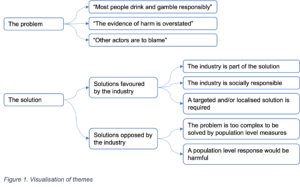
The issue
Regulating unhealthy commodity industries (UCIs) – for example the tobacco, alcohol, gambling and ultra-processed food industries – is complex, at least partly due to their corporate political activity (CPA).
CPA is the way in which corporations use their power to influence policy decisions and the policy environment in favour of consumption of their products. In policy making, CPA can be used as a means to ‘frame’ harms from UCIs in a way that seeks to prevent, delay or weaken policies that are in the interest of public health.
Framing can be a way to promote certain views and perspectives around a UCI’s harms and their solutions. Evidence from the tobacco and alcohol industries suggest that UCIs use similar strategies and framing; for example, misrepresenting evidence of harm and emphasising ‘individual responsibility’ are common strategies to undermine policy.
What did we do?
Our recent study published in the European Journal of Public Health aimed to compare and contrast strategies, arguments and framings used in alcohol and gambling industries’ responses to UK government consultations.
We choose to compare these two industries because they:
- Are common in modern society
- Can lead to health harms
- Often co-occur
- Represent major public health concerns
- Are embedded social norms
- And have a generally ‘liberal’ set of laws governing them
We compared alcohol industry and gambling industry responses to two House of Lords (HoL) inquiries:
- The HoL inquiry into the Alcohol ‘Licensing Act 2003: post-legislative scrutiny’ (carried out in 2016)
- The HoL inquiry into the ‘Social and Economic Impact of the Gambling Industry’ (carried out in 2019)
Responses were analysed using (a mainly inductive) thematic analysis. Themes in the frames, arguments and strategies used by the alcohol and gambling industries in CPA were compared.
What did we find?
Both industries largely used the same framing of the problem of harms from their products, and potential solutions. Many themes in the strategies and framings used by the alcohol and gambling industries were identified, but the eight most salient themes are presented below (see Figure 1 for visualisation of these themes):

Three themes in how the problem was framed were identified:
1. “Most people drink and gamble responsibly”
Alcohol industry and gambling industry actors framed the problem of alcohol/gambling similarly, emphasising harms were only experienced by a minority of people while the majority drink/gamble responsibly.
2. “The evidence of harm is overstated”
Downplaying the harm from alcohol and gambling was also common. This took the form of claiming alcohol use disorders/problem gambling prevalence is low, or pointing out flaws in gambling research in order to cast doubt on the science and scientists.
3. “Other actors are to blame”
When assigning causation to the problem of drinking/gambling, both the alcohol and gambling industries sought to shift blame to (i) other UCIs and (ii) other parts of their industries.
On-trade alcohol retailers argue that more alcohol is sold by the off-trade, which facilitates binge drinking and that on-trade venues are safer as they are supervised. Similarly, on-shore/land-based gambling operators appeared to seek to shift blame for gambling harms to off-shore (online) gambling operators, where there are fewer safeguards.
Five themes in how the solution was framed were identified:
The framing of the solution to ‘problem’ alcohol use/gambling by industry actors can be split into two categories: (1) solutions favoured by the industry, and (2) solutions opposed by the industry. The way the problem was framed (i.e. only affecting a minority of irresponsible or ‘at risk’ consumers), appeared to affect the solutions that were promoted (local and targeted) or discouraged (population level regulation) by the industries.
Solutions favoured by the industry
1. The industry is part of the solution
2. The industry is socially responsible
3. A targeted and/or localised solution is required
In the majority of responses, both the alcohol and gambling industries presented themselves as part of the solution, emphasising the importance and advantages of working with industry stakeholders. As part of this, industry actors also portrayed themselves as ‘socially responsible’. Being socially responsible was generally used as an argument to oppose any further regulation of industry.
As above, the majority of alcohol and gambling industry responses framed alcohol and gambling harm as a problem for only a minority of ‘irresponsible’ or ‘at-risk’ consumers, and therefore implied that solutions should be targeted at such individuals, so that we don’t compromise enjoyment for ‘responsible’ consumers.
Solutions opposed by the industry
Most alcohol industry and gambling industry responses were mainly opposed to population level measures, which can be split into two key themes:
4. The problem is too complex to be solved by population level measures
Both alcohol and gambling industry actors framed population level approaches as ‘too simple’ to be able to solve issues as ‘complex’ as ‘problem’ drinking/gambling. Complexity arguments manipulate public health concepts in order to undermine scientific consensus over population level measures and aim to distance industry as major contributors to gambling/alcohol harms.
5. A population level response would be harmful
Both industry actors also commonly listed the potential harms of implementing population level measures. Harms suggested by the industry can be split into three categories: (1) harms to the consumer (e.g. reducing consumer choice) (2) harms to a ‘responsible’ industry (e.g. impacting businesses and jobs) and (3) harms to the wider economy. Both industries also highlighted how regulation ignores the benefits of their industries; for example, the cultural contribution of pubs/bars, social aspects and enjoyment.
Why is this important and what are the next steps?
Investigating and comparing frames, arguments and strategies used by the alcohol and gambling industries is essential to building a successful public health response to the harms caused by these industries.
We found striking similarities in the framing and arguments used by both industry actors. This study supports calls by researchers to take a unified approach to research and action across UCIs and learn from past successes and failures of public health responses to the alcohol (and tobacco) industry to inform future work.
Written by Saloni Bhuptani, former master’s student at the London School of Hygiene and Tropical Medicine.
All IAS Blogposts are published with the permission of the author. The views expressed are solely the author’s own and do not necessarily represent the views of the Institute of Alcohol Studies.
